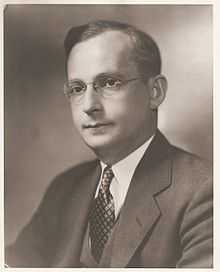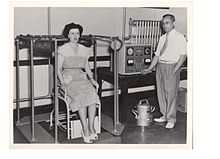Saul Hertz

Saul Hertz, M.D. (April 20, 1905 – July 28, 1950) was an American physician who discovered the use of radioactive iodine for the treatment of thyroid disease.
Early life and education
Hertz was born on April 20, 1905, to Aaron Daniel (A.D.) Hertz and Bertha Hertz in Cleveland, Ohio. His parents were Jewish immigrants from Europe who raised their seven boys according to Orthodox traditions. His father was a successful real estate developer. He attended public school, and then graduated from the University of Michigan with Phi Beta Kappa honors. He received his M.D from Harvard Medical School in 1929, and performed his internship and residency at Cleveland's Mount Sinai Hospital.[1]
Early studies with radioactive Iodine
Hertz joined the Thyroid Clinic and Metabolism Laboratories at Massachusetts General Hospital in 1931.[2]
Hertz served as Chief of the Thyroid Clinic from 1931-1943. In 1936, he spontaneously asked Massachusetts Institute of Technology president Karl Compton, “Could iodine be made artificially radioactive?” [3] Compton responded in a letter to Dr. Hertz on December 15, 1936, describing radioactive iodine.[4]
In 1937, in collaboration with the physicist Arthur Roberts of MIT, he began studies in rabbits to evaluate the effects of I-128 produced in very small quantities by neutron bombardment on the thyroid.[5] The experiment involving 48 rabbits demonstrated the tracer capabilities of radioactive iodine and its effects on the thyroid gland. The studies showed that the hyperplastic thyroid gland absorbed more of the radioactive substance than the normal gland.[6] This proved the tracer qualities of the radioactive substance.[7] The tracer procedure was critical for determining the amount of iodine the human thyroid took up so that a calculation of the dosage of radioactive iodine could be calibrated for treatment.[8]
Human treatment with radioactive iodine

Human studies required a better source of the radioactive Iodine. The building of the cyclotron at MIT was funded for $30,000 by the Mary Markle Foundation of New York City in 1938. The construction project that was completed two years later in 1940. During those two years, the experiments with rabbits continued.[9]
In January 1941, Hertz administered cyclotron produced a I-130 - I-131 mixture as a therapeutic dose to the first human patient at MGH, to a patient with Graves’ hyperthyroidism, or Graves' disease.[10] This was the first successful treatment of humans with an artificially produced radioactive material.[11]
Gradually a series of 29 patients were treated and documented. The Journal of the American Medical Association published “Radioactive Iodine in the Study of Thyroid Physiology”, May 1946. This article was a five year follow up study of the 29 patients and documented the successful treatment and safety of radioactive iodine for the treatment of hyperthyroidism. The follow-up study firmly launched the use of radioactive iodine therapy as a standard treatment for Graves’ disease.[9]
World War II
In 1943, Hertz joined the Navy Medical Corps. He was part of the Manhattan Project for Biology and Medicine in furthering medical uses of atomic energy.[12] He served as a Commander and continued his service in the Naval Reserves.[13]
Nuclear fission products in cancer treatment
As the interest in atomic energy for peaceful purposes was heightened, after the explosion of the atomic bomb, Hertz established the Radioactive Isotope Research Institute in Boston, Massachusetts, in 1946. Its purpose was to apply fission products to the treatment of thyroid cancer, goiter, and other malignant growths. He worked with the government to centralize an agency to handle the distribution of radioactive isotopes for use by private enterprises working on approved projects.[14] He made extensive studies of radioactive iodine in the treatment of thyroid cancer as well as in the production of total thyroidectomy in the treatment of certain cases of heart disease.[5] Hertz studied the application of radioactive phosphorus and the influences of hormones on cancer as displayed by isotope studies.[13]
Later career and influence
Hertz wrote over 50 scientific publications dealing mainly with topics in thyroid physiology, its disease and treatment. He influenced the development of nuclear medicine through his research and instruction at both Harvard and MIT. He was an instructor in medicine at Harvard Medical School and Harvard University from 1946 - 1950. His teaching included an attachment to the Nuclear Physics Department at Massachusetts Institute of Technology from 1939 - 1950.[13]
The development of radioactive iodine in the treatment of thyroid disease is the cornerstone on which nuclear medicine was built.[9]Barbara Bush, who was successfully treated, wrote to Vitta Hertz, his widow, “It is comforting to know that so many people are well because of the scientific expertise of people like Dr. Hertz.” [15]
Selected honors
- Dalton Scholar - Massachusetts General Hospital - 1931 - 1933
- Henry Pickering Wolcott Fellow - Harvard Medical School - 1935 - 1937
- Key to Science/Sigma XI - Massachusetts Institute of Technology (Scientific Society) - 1940
See also
- Nuclear Medicine
- Radioactive iodine
- Hyperthyroidism
References
- ↑ Hay, Ian, ed. (2008). Clinical Endocrine Oncology (2nd ed.). Blackwell. pp. xvi–xx. ISBN 978-1-4051-4584-8.
- ↑ John Bruton Stanbury's book, A constant ferment: a history of the Thyroid Clinic and Laboratory at Massachusetts General Hospital, 1913-1990
- ↑ American Thyroid Association. 74th Annual meeting of the American thyroid association program and abstracts. California: VA Greater Los Angeles Healthcare System, 2002;17. (digital copy available from the American Thyroid Association (http://www.thyroid.org/ann_mtg/2003_75th/documents/endowment_donors.pdf)
- ↑ Compton, Karl T. (1936 December 15). Letter to Dr. S. Hertz. Courtesy of the MIT Archives.
- ↑ 5.0 5.1 Bander, Martin (1987). "Remembering the Early Days of Nuclear Medicine". MGH News (Massachusetts General Hospital) 46 (6): 5–6.
- ↑ Hertz, S.; Roberts, A. (1940). "Radioactive Iodine as an Indicator in Thyroid Physiology". The American Journal of Physiology 128 (3): 565–576.
- ↑ Soley M, Miller E,. Symposium on Endocrinology: Treatment of Graves’ Disease with Radioactive iodine.Medical Clinics of North America 1948 32;3-17.
- ↑ Hertz S, Roberts A, Salter WT. Radioactive iodine as an indicator in thyroid physiology, IV: the metabolism of iodine in Graves’ disease. Journal of Clinical Investigation 1942;21:25-29.
- ↑ 9.0 9.1 9.2 Hertz, Barbara, Schuleller, Kristin, Saul Hertz, MD (1905 - 1950) A Pioneer in the Use of Radioactive Iodine, Endocrine Practice 2010 16,4;713-715.
- ↑ Fragu, Philippe, How the field of thyroid endocrinology developed in France after World War II, Bulletin of the History of Medicine, 1948 77,2:393-414.
- ↑ Hertz S, Roberts A, Means JH, Evans RD. Radioactive iodine as an indicator in thyroid physiology, II: iodine collection by normal and hyperplastic thyroids in rabbits. American journal of physiology 1940; 565 - 576.
- ↑ Fragu, Philippe, How the field of thyroid endocrinology developed in France after World War II, Bulletin of the History of Medicine, 1948 77,2:393-414.
- ↑ 13.0 13.1 13.2 Kagan, Solomon (1950). "Saul Hertz, M.D.". The Medical Way 12 (12): 1, 6–7.
- ↑ Vincent, Donald. (1949 May 24). Hertz to Use Nuclear Fission in Cure for Cancer. The Harvard Crimson, May 24, 1949.
- ↑ News and Public Affairs Office of MGH. 50th Anniversary of “atomic cocktail” to treat overactive thyroid gland. MGH Hotline 1991, Jan 31;1-3.